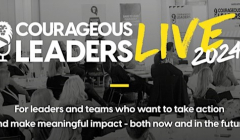
Embracing empowerment and relinquishing control
At Courageous Leaders Live 2024 leaders discuss the importance of time, feedback and making space for others

NHS short film, The Rhythm of Life, celebrates the return of live theatre and events whilst encouraging the British public to get vaccinated

Vaccination is our golden ticket to freedom as we know it and with that, the return of live music and theatres. The UK arts and culture sector has faced possibly its hardest 18 months on record, with venues, theatres and creative spaces facing closure, we've had to find new ways to adapt whilst keeping ourselves safe.
The Rhythm of Life is the new NHS short film celebrating the return of theatre and events whilst encouraging the remainder of the British public to get vaccinated. The film’s cast of the best of British theatre and television joined the show to sing and dance to a message we can all get behind. We see the likes of Jim Broadbent, Nicola Roberts, David Walliams and Russell Tovey singing and dancing in this all-star line-up.
This project and its sound editing were outsourced remotely to our team at Soundtrack Creation, a practice now common thanks to the last 18 months.
The arts have faced huge challenges and yet we overcome them with a shared passion that is unflappable even in the face of crises.
Sefi Carmel, Composer, Sound Designer, Producer and Mixer
The process for creating the NHS video starts with filming on set from Standalone Pictures, which was directed by Josie Rourke. This is followed by post production editing team Onsight delivering the project, with music and dialogue for us to process.
Layering the musical fragments into a DAW (digital audio workstation) along with any additional audio such as actors dialogue comes first, and our team can start construction on the mix.
Once on the table, it is the mixing engineer's job to piece together this complex puzzle, making sure that every sound is heard.
Here, actors like David Walliams stand up to profess the rhythm of life, whilst singers Sandra Marvin and Nicola Roberts provide vocals. Tap dancers stamp their sound onto set whilst both curtain and stage provide their own sonic presence.
Listening back to the video you can hear that every sound has its place, nothing hits you square on. This first step is to ensure a balance so that the listener can hear everything from the recording, but with subtlety. As if you yourself are in the shoes of Jim Broadbent who sits gleefully in the empty seats of the London Theatre, toe-tapping his way through the production.
With audio now synced and time-aligned to picture and music carefully layered, it's time for the final polish. Using an array of digital and analogue gear we give the track its final mastering, allowing the sounds of brass to pop and vocals to sparkle.
Work on this ad was all completely remote and the film was turned around in a record time of one day, ready for distribution without the need for any physical meeting between the creative departments.
When looking at the methods and speed with which this important film was made, it begs the question as to whether this form of remote production is set to be the new norm?
Whilst collaboration can be enjoyed through face-to-face interaction, the speed at which we can now hand projects over from department to department is unmistakably efficient. Productivity is now more important than ever with budgets and funding becoming tighter by the year.
There is no denying that things are going to be different from now on. Studios are now hosting remote recording sessions and the advancements in video teleconferencing software allow us to now do that. What the last 18 months has given us is time (that's for sure!), and in that time we've all implemented a lot of changes into our day to day to accommodate the new common ways of working. So have most organisations.
What hasn't changed is the old attitude, the arts have faced huge challenges and yet we overcome them with a shared passion that is unflappable even in the face of crises. These issues that were once considered roadblocks to the creative experience have now morphed into opportunities. For me, the way I see it is that the changes we’ve all been forced to adopt have actually helped hundreds of artists mix and master their projects over the pandemic from a remote, cloud-based system. It has improved accessibility and levelled the playing field, we now have staff all over the UK for example and we know we’re not alone. It has also allowed people to focus on what is important.
We find ourselves in a unique position where music and the arts has gained a skill in working remotely, improving the way we now approach new projects. This ad is a testament to remote craft, the resilience of the production industry, and a beacon of light for a hopeful future – one jab at a time.
Sefi Carmel is an award winning London based composer, sound designer, producer and mixer. He has been creating soundtracks for films, TV, commercials and games for over 2 decades. His diverse credits range from work on A list Hollywood feature films with the likes of Ridley Scott, John Woo, Chris Columbus, Cameron Macintosh, and Kevin Reynolds; to mixing, remixing and mastering tracks for David Bowie, Phil Collins, Bruno Mars, Michael Bublé, Massive Attack, BB king and many more. He has enjoyed success creating scores and soundtracks for Netflix, Amazon, Disney, UIP, Buena Vista, Scott Free, BBC, MTV, ITV, National Geographic, Discovery, Sky, Five, Channel 4, and many more.
Looks like you need to create a Creativebrief account to perform this action.
Create account Sign inLooks like you need to create a Creativebrief account to perform this action.
Create account Sign in